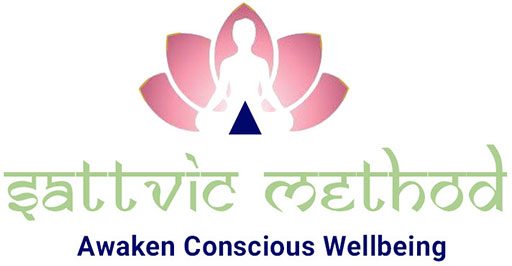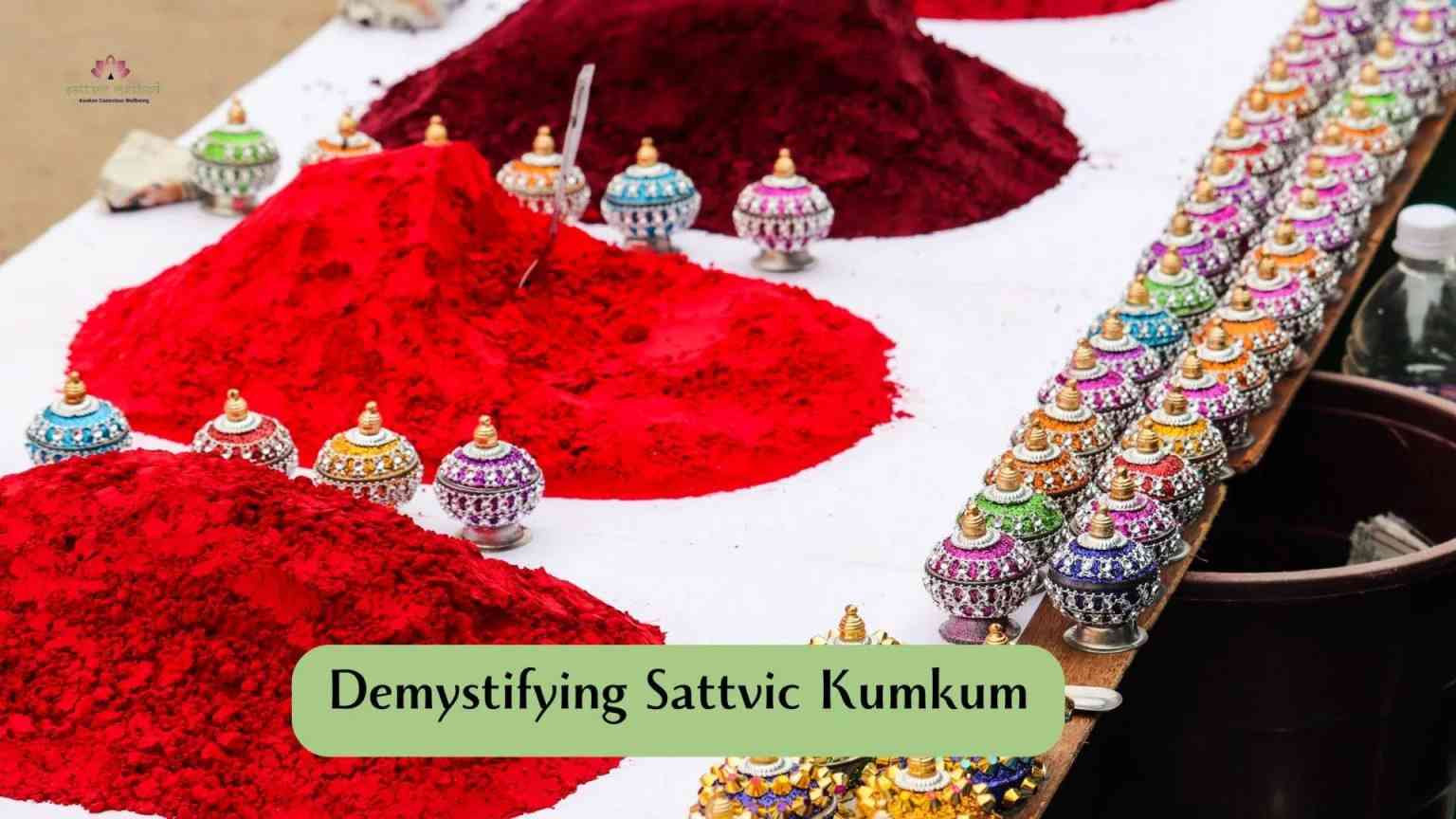Demystifying Sattvic Kumkum: Unlocking the Spiritual Power of a Sacred Tradition
Introducing Sattvic Kumkum: A Powerful Tradition
In the heart of ancient Indian spirituality lies a humble yet powerful substance—kumkum, the radiant red powder often seen gracing the foreheads of seekers, saints, and householders alike. Far more than a decorative mark, kumkum holds deep spiritual resonance, symbolizing divine energy, purity, and auspiciousness.
Derived traditionally from turmeric and lime, this crimson blessing is especially potent when prepared and applied with sattvic intentions—those grounded in peace, clarity, and inner harmony. Unlike rajasic (stimulating) or tamasic (dulling) substances, sattvic kumkum is energetically clean, ethically sourced, and vibrationally aligned with higher consciousness.
Its vibrant red hue isn’t just visually striking—it’s a symbol of Shakti, the feminine creative force, and a powerful reminder of our own inner light. Whether used in sacred ceremonies or quiet moments of mindfulness, sattvic kumkum carries the essence of centuries-old wisdom, waiting to be awakened in your everyday life.
Sattvic Kumkum: The Power of Intention
In the vast landscape of Indian spiritual traditions, intention (or sankalpa) is more than a passing thought—it is the seed that shapes our inner and outer worlds. In the realm of sattvic living, where purity, clarity, and harmony guide our practices, how we do something is just as vital as what we do.
This is especially true when it comes to the sacred application of sattvic kumkum—a vibrant red powder made from natural, ethically sourced ingredients like turmeric and slaked lime. While kumkum may appear as a simple mark on the skin, when applied with focused intention, it transforms into a potent spiritual tool that channels energy, enhances awareness, and aligns you with your highest self.
The Sattvic Approach: Why Intention Matters
At the heart of sattvic practice is conscious living—a way of being that is aligned with purity (sattva), mindfulness, and elevated energy. Unlike rajasic (driven by ego or desire) or tamasic (rooted in inertia) actions, sattvic actions are deliberate, peaceful, and infused with purpose.
When applying kumkum, your mental state and emotional tone directly influence its energetic effect. The mark on your forehead becomes more than a symbol—it becomes a transmitter of your intention, a focal point for energy flow, and a daily affirmation of your spiritual journey.
Kumkum as a Spiritual Conduit
The spot where kumkum is traditionally applied—the space between the eyebrows (Ajna chakra or third eye)—is considered a powerful energy center. This chakra governs intuition, perception, clarity, and inner vision. When you apply sattvic kumkum here with a clear, positive intention, you’re activating this energy center, sending a message not just to your mind, but to the Universe.
Think of kumkum as a spiritual switch that turns on your inner light. But for it to work fully, your intention is the electricity that powers it.
How to Infuse Kumkum with Intention: Step-by-Step Guide
- Pause Before You Begin
Sit quietly. Breathe deeply. Let your mind settle. This silence is the gateway to intention. - Speak or Think Your Intention
Choose a simple affirmation or mantra aligned with your goal. Speak it silently or aloud.
Examples:- “I am protected and divinely guided.”
- “I welcome healing and wholeness into my life.”
- “I attract abundance, love, and clarity.”
- Apply with Awareness
Dip your right ring finger into the sattvic kumkum and gently apply it to your third eye, throat, or any sacred point, keeping your intention alive in your mind. - Seal the Energy
Place your hands in prayer or on your heart. Take one more breath and visualize the energy of your intention anchoring in your being.
Intention-Specific Applications: Examples for Daily Practice
1. For Protection
- Affirmation: “I am surrounded by light and shielded from negativity.”
- Application Spot: Third eye (Ajna chakra)
- Best Time: Before leaving the house or starting the day
- Tip: Visualize a golden light forming a protective aura around you as you apply kumkum.
2. For Healing (Emotional or Physical)
- Affirmation: “My body and mind are in perfect balance. I am whole.”
- Application Spot: Heart center or forehead
- Best Time: Morning or before meditation
- Tip: Use after a healing bath or yoga session for enhanced vibrational effect.
3. For Prosperity and Abundance
- Affirmation: “I attract wealth, opportunities, and joy effortlessly.”
- Application Spot: Center of palms or forehead
- Best Time: During Lakshmi puja, new moon rituals, or before important financial decisions
- Tip: Combine this practice with gratitude journaling to amplify your manifestation energy.
4. For Mental Clarity and Focus
- Affirmation: “My mind is clear, focused, and aligned with my purpose.”
- Application Spot: Just above the eyebrows or the crown of the head
- Best Time: Before work, study, or creative tasks
- Tip: Use alongside sandalwood or lavender incense for extra focus.
Why It Works: The Science Behind the Energy
Modern studies in neuroscience and epigenetics support what sages have known for millennia: our thoughts and emotions directly influence our physical reality.
When you apply kumkum with a focused, positive intention:
- You stimulate pressure points and neural pathways (especially around the pineal gland).
- You create a neuro-associative trigger, linking the physical act to your affirmation.
- Over time, this creates powerful mental and energetic reprogramming.
This is spiritual psychology in action, and sattvic kumkum is one of the simplest yet most profound tools to support this transformation.
Make It Yours: Daily Ritual, Elevated Life
You don’t have to wait for a festival or special puja to bring sacred energy into your day. Even a 30-second kumkum ritual—done with focus and love—can ground you, energize you, and keep your vibration high throughout the day.
By using natural sattvic kumkum (free of chemicals and made with pure intention), and pairing it with your daily sankalpa, you’re not just following tradition. You’re evolving it. You’re turning a timeless practice into a modern-day self-care ritual for the soul.
Final Thought: Intention is Everything
In sattvic living, the essence is always in the subtle—the breath, the thought, the feeling behind the action.
So the next time you touch that small pinch of red powder, pause. Breathe. Align. Set your intention. Let sattvic kumkum become your daily anchor, your spiritual reminder, and your sacred signature to the universe.
📢 We Want to Hear from You!📢
Have you tried applying kumkum with intention? What mantras or affirmations resonate with you most?
Share your ritual stories using #SattvicKumkum or tag us on Instagram! Your story may inspire someone else’s transformation.
Sattvic Kumkum Rituals: A Step-by-Step Guide to Sacred Daily Practice
Harnessing the Divine Energy of Tradition through Intention and Ritual
In the ancient spiritual traditions of Sanatana Dharma, every act is an offering, every moment a chance to connect with the Divine. Among the simplest yet most profound of these daily acts is the application of kumkum—a red mark not just worn, but honored.
In this guide, we explore how to perform sattvic kumkum rituals with clarity, reverence, and intention, rooted in the teachings of our shastras. When done mindfully, this small act becomes a bridge between the jiva (individual soul) and the Paramatma (Supreme Soul)—offering protection, clarity, energy, and spiritual elevation.
Why Ritual Matters in the Sattvic Path
In the Bhagavad Gita (9.26), Lord Krishna says:
“Patram pushpam phalam toyam yo me bhaktya prayacchati,
tad aham bhakty-upahritam ashnami prayatatmanah.”
“Whoever offers Me with love and devotion a leaf, a flower, fruit, or water, I accept that offering of the pure-hearted devotee.”
Even the simplest offering—like the application of sattvic kumkum—when done with devotion (bhakti), becomes spiritually potent. This is the heart of sattvic ritual: purity of substance, purity of intention, and purity of heart. Doing it every day will deepen your spiritual practices.
Step-by-Step Sattvic Kumkum Ritual
This daily practice is suitable for both men and women, as long as it is done with the right bhava (feeling) and understanding.
Preparation: Create a Sacred Space
- Cleanse yourself: You can apply Kumkum after you Bathe every morning. If you are doing it other times of the day, wash your face and hands as symbolic purification. If possible, perform a quick achamana (sipping water with mantra) or mentally chant “Shree Matrae Namaha.”
- Face East or North, directions of auspiciousness and clarity.
- Place your kumkum in a clean container, ideally copper, brass, or silver—not plastic.
- Light a diya (lamp) or incense if possible, to invite divine energy.
Invocation (Dhyana)
Close your eyes. Focus on your breath. Chant silently or aloud:
“Om Shree Gurubhyo Namaha”
“Om Gan Ganapataye Namaha”
Invoke the presence of your Ishta Devata (personal deity) or simply the universal Shakti.
Application of Sattvic Kumkum
1. Take a small pinch of kumkum with the right ring finger, the finger of aakash tattva (space/ether), which connects us to subtle energies.
2. Apply it gently on the forehead (Ajna chakra), right between the eyebrows. This is the seat of intuition, concentration, and inner vision.
While applying, chant:
“Om Aim Hreem Kleem Chamundaye Vichche” (for protection and clarity)
or
“Om Tat Sat” (for aligning with truth and sattva)
Ritual Variations Based on Intention
For Protection
- Affirmation: “I am guided and protected by Divine Shakti.”
- Application: Forehead + throat (Vishuddha chakra)
- Mantra: “Om Dum Durgaye Namaha”
This strengthens your auric field, especially when stepping out or before facing challenges.
For Healing (Body + Emotions)
- Affirmation: “Healing flows through every cell of my being.”
- Application: Forehead + heart center
- Mantra: “Om Tryambakam Yajamahe Sugandhim Pushtivardhanam”
This connects you to the healing energy of Lord Shiva (Mahadeva).
For Prosperity
- Affirmation: “Abundance flows freely into my life.”
- Application: Forehead + base of the thumbs (associated with wealth in palmistry)
- Mantra: “Om Shreem Mahalakshmyai Namaha”
Perform this before business meetings or financial decisions.
For Grounding and Surrender
- Affirmation: “I am rooted in Dharma and trust the path.”
- Application: Top of the feet or soles (only in private space; not to be done in temples)
- Mantra: “Om Namo Bhagavate Vasudevaya”
This is especially helpful for those who feel overwhelmed or scattered.
Customizing Your Practice
Every jiva is unique, and so should be your connection with the Divine. Once you understand the fundamentals, feel free to develop a personal ritual that fits your daily rhythm.
Ideas for Personalized Practice:
- Combine your kumkum ritual with Gayatri Japa or silent meditation.
- Apply kumkum before yoga or chanting sessions for focus and energy alignment.
- Men may also apply kumkum or sandalwood paste during adhyayana (study of scriptures) for clarity and divine remembrance.
Scriptural Backing & Vedic Significance
In the Lalita Sahasranama, the Divine Mother is described as:
“Kumkuma-rakta-varnabhām” — She who is colored in the red hue of kumkum.
Kumkum represents Shakti tattva, the active creative principle in the universe. When you place it on your body, you are inviting this Shakti into your subtle body, aligning with the cosmic feminine regardless of your gender identity.
The Agamas and Puranas also speak of applying kumkum at sacred spots on the body as a means to:
- Protect from negative energies,
- Awaken dormant chakras, and
- Sanctify the physical body as a temple of the soul.
Encouragement for Every Seeker
Dear reader, this path is not about perfection, but presence.
You do not need elaborate altars or complex rituals.
What matters is your sincerity, your faith, and your willingness to invite the sacred into the everyday.
By incorporating this simple sattvic kumkum ritual, you align your body, mind, and soul with higher consciousness—one sacred gesture at a time.
Begin Today
Try the ritual tomorrow morning before work or meditation.
Journal the effects you feel after a week of daily practice.
Share your ritual using #SattvicKumkumRitual—and inspire others to begin.
Together, let us reawaken the beauty of samskruti—not in temples alone, but in our hearts, our homes, and our hands.
Decoding Kumkum: Common Mistakes to Avoid
In the sacred traditions of Sanatana Dharma, kumkum—the striking red powder applied to the forehead—is far more than cultural decoration. It is a symbol of spiritual awareness, protection, divine energy, and inner alignment. Yet in today’s fast-paced world, many have either misunderstood its purpose or abandoned it altogether. Some avoid wearing it due to modern stigmas, while others limit its use to temples or festivals.
Let us correct these misconceptions, reconnect with Kumkum’s sattvic origins, and encourage its revival—not just as a religious symbol but as a daily tool for personal growth, energetic clarity, and self-empowerment.
❌ Myth 1: “Kumkum is Only for Religious Purposes”
One of the most widespread misunderstandings is that kumkum is solely for ritualistic ceremonies or religious rites. While it certainly holds sacred significance during pujas, homas, and temple visits, its essence extends far beyond ritual.
In the Vedas and Agamas, kumkum is recognized as a daily energy activator, meant to stimulate the Ajna chakra (third eye) and protect the wearer from negative influences.
In the Bhagavad Gita and Shiva Purana, great sages like Rishi Narada and householders alike are seen adorned with tilak or kumkum, as part of their dharma—their conscious lifestyle.
Wearing kumkum is not limited to women, nor is it limited to Hindus. It is a universal symbol of spiritual awareness and sacred connection, appropriate for anyone walking the path of inner growth.
Kumkum as a Tool for Daily Balance and Energy Alignment
Kumkum can—and should—be part of your daily self-care and spiritual hygiene. Like brushing your teeth or bathing, applying kumkum with intention helps purify and elevate your consciousness.
Benefits of Daily Kumkum Application:
- Activates the pineal gland, supporting clarity and intuition
- Strengthens mental focus and emotional balance
- Serves as an energetic shield against negativity
- Instills a deep sense of grounding and inner peace
- Reminds you to live consciously and spiritually aligned
Whether you’re heading to work, attending class, or simply starting your day, a small mark of kumkum can serve as your personal sankalpa (intention)—a commitment to higher awareness and divine remembrance.
Mistake 2: Using Synthetic or Chemically Treated Kumkum
Sadly, many kumkum powders on the market today are made with artificial dyes, including harmful lead oxide, mercury sulfide, and carcinogenic colorants—far from sattvic and often dangerous to health.
For a truly sattvic experience, it is essential to:
- Use kumkum made from pure turmeric and natural lime
- Ensure it is lead-free, chemical-free, and ethically sourced
- Prefer small-batch, artisan-made kumkum from traditional Vedic practitioners or ayurvedic sources
Just as we are mindful of what we eat or apply to our skin, the energetic quality of what we wear on our body and chakras matters deeply. When you use high-quality sattvic kumkum, you’re not just adorning yourself—you are nourishing your subtle body.
Follow our YouTube video to make Kumkum at home!
Global Cultural Parallels: Kumkum Beyond Borders
While kumkum originates in Hindu dharmic traditions, the ritual of marking the forehead is present in various spiritual paths:
- ✝️ Ash Wednesday (Christianity): In Catholic and Anglican traditions, ashes are applied to the forehead to symbolize humility, repentance, and remembrance of spiritual mortality.
- ☪️ Islamic Sufism: The concept of the “mark of prayer” (zabiba) on the forehead from consistent salah (prostration) is considered a sign of devotion.
- 🔯 Taoist and Buddhist Monks in East Asia often wear marks of sacred ash or vermillion during certain initiations.
This shows that the forehead chakra is universally recognized as a portal to higher consciousness—a sacred center across wisdom traditions.
Why You Should Start Wearing Sattvic Kumkum Daily
Whether you’re a student, a working professional, a homemaker, a healer, or a seeker, kumkum belongs to you. It is a daily act of sovereignty, a small but mighty ritual that declares:
“I honor my body as sacred. I protect my mind as divine. I walk this day with awareness.”
By reclaiming the practice of wearing kumkum:
- You ground yourself in your culture, roots, and spiritual path
- You maintain energetic clarity in a world of constant stimulation
- You inspire others to live consciously and traditionally
- You embody the balance of inner and outer purity that defines the sattvic path
How to Start: Simple Daily Practice
- Choose pure, organic sattvic kumkum (turmeric-based, chemical-free)
- Each morning, before stepping out or beginning your sadhana:
- Breathe deeply
- Set a clear intention (peace, focus, protection, etc.)
- Apply kumkum to your third eye (Ajna) or heart center
- Recite a mantra like “Om Shanti Shanti Shanti” or “Om Namo Narayanaya”
Repeat daily. Watch your energy, focus, and spiritual sensitivity evolve.
Join the Kumkum Revival Movement
This is your invitation to begin a daily sattvic kumkum ritual, not as a religious obligation, but as a soulful practice that aligns you with truth, beauty, and inner strength.
Share your photos, rituals, and experiences with the hashtag #WearYourKumkum and #SattvicEveryday—and inspire a new wave of spiritual mindfulness rooted in tradition.




